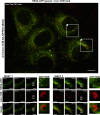Dynamic imaging of the hepatitis C virus NS5A protein during a productive infection
- PMID: 24429364
- PMCID: PMC3993538
- DOI: 10.1128/JVI.02490-13
Dynamic imaging of the hepatitis C virus NS5A protein during a productive infection
Abstract
Hepatitis C virus (HCV) NS5A is essential for viral genome replication within cytoplasmic replication complexes and virus assembly at the lipid droplet (LD) surface, although its definitive functions are poorly understood. We developed approaches to investigate NS5A dynamics during a productive infection. We report here that NS5A motility and efficient HCV RNA replication require the microtubule network and the cytoplasmic motor dynein and demonstrate that both motile and relatively static NS5A-positive foci are enriched with host factors VAP-A and Rab5A. Pulse-chase imaging revealed that newly synthesized NS5A foci are small and distinct from aged foci, while further studies using a unique dual fluorescently tagged infectious HCV chimera showed a relatively stable association of NS5A foci with core-capped LDs. These results reveal new details about the dynamics and maturation of NS5A and the nature of potential sites of convergence of HCV replication and assembly pathways.
Importance: Hepatitis C virus (HCV) is a major cause of serious liver disease worldwide. An improved understanding of the HCV replication cycle will enable development of novel and improved antiviral strategies. Here we have developed complementary fluorescent labeling and imaging approaches to investigate the localization, traffic and interactions of the HCV NS5A protein in living, virus-producing cells. These studies reveal new details as to the traffic, composition and biogenesis of NS5A foci and the nature of their association with putative sites of virus assembly.
Figures










References
Publication types
MeSH terms
Substances
LinkOut - more resources
Full Text Sources
Other Literature Sources
Research Materials

